Characteristics and Controlling Factors of Natural Fractures in Continental Tight-Oil Shale Reservoir
Abstract
:1. Introduction
2. Geological Setting
3. Materials and Methods
4. Fracture Characterization
4.1. Fracture Types and Characteristics
4.2. Quantitative Fracture Characterization
5. Discussion
5.1. Mineral Composition and Content
5.2. Mechanical Stratigraphy
5.3. Lithofacies
5.4. Fault
5.5. Abnormal High Pressure
6. Conclusions
Author Contributions
Funding
Data Availability Statement
Acknowledgments
Conflicts of Interest
References
- Gale, J.F.W.; Olson, J.E.; Laubach, S.E. Natural fractures in shale: A review and new observations. AAPG Bull. 2014, 98, 2165–2216. [Google Scholar] [CrossRef]
- Liu, B.; Shi, J.X.; Fu, X.F.; Lyu, Y.F.; Sun, X.D.; Gong, L.; Bai, Y.F. Petrological characteristics and shale oil enrichment of lacustrine fine-grained sedimentary system: A case study of organic-rich shale in first member of Cretaceous Qingshankou Formation in Gulong Sag, Songliao Basin, NE China. Pet. Explor. Dev. 2018, 45, 884–894. [Google Scholar] [CrossRef]
- Luo, Q.Y.; Gong, L.; Qu, Y.S.; Zhang, K.H.; Zhang, G.L.; Wang, S.Z. The tight oil potential of the Lucaogou Formation from the southern Junggar Basin, China. Fuel 2018, 234, 858–871. [Google Scholar] [CrossRef]
- Gao, S.; Zeng, L.B.; Ma, S.Z.; He, Y.H.; Gong, L.; Zhao, X.Y.; Xu, W.G.; Tang, X.M. Quantitative prediction of fractures withdifferent directions in tight sandstone reservoirs J. Nat. Gas Geosci. 2015, 26, 427–434. [Google Scholar]
- Luo, Q.R.; Goodarzi, F.; Zhong, N.N.; Wang, Y.; Qiu, N.S.; Skovsted, C.; Such, V.; Schovsbo, N.H.; Morga, R.; Xu, Y.H.; et al. Graptolites as fossil geo-thermometers and source material of hydrocarbons: An overview of four decades of progress. Earth-Sci. Rev. 2020, 200, 103000. [Google Scholar] [CrossRef]
- Li, Y.G.; Gong, L.; Zeng, L.B.; Ma, L.H.; Yang, H.; Zang, B.J.; Zhu, K.W. Characteristics of fractures and their contribution to the deliverability of tight conglomerate reservoirs in the Jiulongshan Structure, Sichuan Basin J. Nat. Gas Ind. 2012, 32, 22–26. [Google Scholar]
- Gottardi, R.; Mason, S.L. Characterization of the natural fracture system of the Eagle Ford Formation (Val Verde County, Texas). AAPG Bull. 2018, 102, 1963–1984. [Google Scholar] [CrossRef]
- Ladevèze, P.; Séjourné, S.; Rivard, C.; Lavoie, D.; Lefebvre, R.; Rouleau, A. Defining the natural fracture network in a shale gas play and its cover succession: The case of the Utica Shale in eastern Canada. J. Struct. Geol. 2018, 108, 157–170. [Google Scholar] [CrossRef] [Green Version]
- Shovkun, I.; Espinoza, D.N. Geomechanical implications of dissolution of mineralized natural fractures in shale formations. J. Pet. Sci. Eng. 2018, 160, 555–564. [Google Scholar] [CrossRef]
- Zeng, L.B.; Lyu, W.Y.; Li, J.; Zhu, L.F.; Weng, J.Q.; Yue, F.; Zu, K.W. Natural fractures and their influence on shale gas enrichment in Sichuan Basin, China. J. Nat. Gas Sci. Eng. 2016, 30, 1–9. [Google Scholar] [CrossRef]
- Smart, K.J.; Ofoegbu, G.I.; Morris, A.P.; McGinnis, R.N.; Ferrill, D.A. Geomechanical modeling of hydraulic fracturing: Why mechanical stratigraphy, stress state, and pre-existing structure matter. AAPG Bull. 2014, 98, 2237–2261. [Google Scholar] [CrossRef]
- Gale, J.F.W.; Gale, R.M.R.; Holder, J. Natural fractures in the Barnett Shale and their importance for hydraulic fracture treatments. AAPG Bull. 2007, 91, 603–622. [Google Scholar] [CrossRef]
- Luo, Q.; Zhong, N.; Dai, N.; Zhang, W. Graptolite-derived organic matter in the Wufeng–Longmaxi Formations (Upper Ordovician–Lower Silurian) of southeastern Chongqing, China: Implications for gas shale evaluation. Int. J. Coal Geol. 2016, 153, 87–98. [Google Scholar] [CrossRef]
- Yin, S.L.; Feng, K.Y.; Nie, X.; Chen, Q.; Liu, Y.; Wang, P.L. Characterization of marine shale in Western Hubei Province based on unmanned aerial vehicle oblique photographic data. Adv. Geo-Energy Res. 2022, 6, 252–263. [Google Scholar] [CrossRef]
- Li, B.K.; Nie, X.; Cai, J.C.; Zhou, X.Q.; Whang, C.C.; Han, D.L. U-Net model for multi-component digital rock modeling of shales based on CT and QEMSCAN images. J. Pet. Sci. Eng. 2022, 216, 110734. [Google Scholar] [CrossRef]
- Liu, B.; Sun, J.H.; Zhang, Y.Q.; He, J.L.; Fu, X.F.; Yang, L.; Xing, J.J.; Zhao, X.Q. Reservoir space and enrichment model of shale oil in the first member of Cretaceous Qingshankou Formation in the Changling sag, southern Songliao Basin, NE China. Pet. Explor. Dev. 2021, 48, 608–624. [Google Scholar] [CrossRef]
- Gong, L.; Wang, J.; Gao, S.; Fu, X.F.; Liu, B.; Miao, F.B.; Zhou, F.B.; Meng, Q.K. Characterization, controlling factors and evolution of fracture effectiveness in shale oil reservoirs. J. Pet. Sci. Eng. 2021, 203, 108655. [Google Scholar] [CrossRef]
- Laubach, S.E.; Lander, R.H.; Criscenti, L.J.; Anovitz, L.M.; Urai, J.L.; Pollyea, R.M.; Hooker, J.N.; Narr, W.; Evans, M.A.; Kerisit, S.N.; et al. The Role of Chemistry in Fracture Pattern Development and Opportunities to Advance Interpretations of Geological Materials. Rev. Geophys. 2019, 57, 1065–1111. [Google Scholar] [CrossRef] [Green Version]
- Gong, L.; Gao, S.; Fu, X.F.; Chen, S.M.; Lyu, B.Y.; Yao, J.Q. Fracture characteristics and their effects on hydrocarbon migration and accumulation in tight volcanic reservoirs: A case study of the Xujiaweizi fault depression, Songliao Basin, China. Interpretation 2017, 5, 57–70. [Google Scholar] [CrossRef]
- Zhu, X.M.; Zeng, H.L.; Li, S.L.; Dong, Y.L.; Zhu, S.F.; Zhao, D.N.; Huang, W. Sedimentary characteristics and seismic geomorphologic responses of a shallow-water delta in the Qingshankou Formation from the Songliao Basin, China. Mar. Pet. Geol. 2017, 79, 131–148. [Google Scholar] [CrossRef]
- Liu, B.; Bai, H.L.; Chi, Y.A.; Jia, R.; Fu, X.F.; Yang, L. Geochemical characterization and quantitative evaluation of shale oil reservoir by two-dimensional nuclear magnetic resonance and quantitative grain fluorescence on extract: A case study from the Qingshankou Formation in Southern Songliao Basin, northeast. Mar. Pet. Geol. 2019, 109, 561–573. [Google Scholar] [CrossRef]
- Huo, Q.; Zeng, H.; Zhang, X.C.; Fang, Q.H.; Wang, Z.Y.; Fu, L. Shale Oil Occurrence and Reservoir Characteristics of the Qijia-Gulong Depression in Songliao Basin. Acta Geol. Sin.-Engl. Ed. 2015, 89, 151–153. [Google Scholar] [CrossRef]
- Marrett, R.; Gale, J.F.W.; Gómez, L.A.; Laubach, S.E. Correlation analysis of fracture arrangement in space. J. Struct. Geol. 2018, 108, 16–33. [Google Scholar] [CrossRef]
- Hooker, J.N.; Laubach, S.E.; Marrett, R. Fracture-aperture size–frequency, spatial distribution, and growth processes in strata-bounded and non-strata-bounded fractures, Cambrian Mesón Group, NW Argentina. J. Struct. Geol. 2013, 54, 54–71. [Google Scholar] [CrossRef]
- Li, J.Z.; Laubach, S.E.; Gale, J.F.W.; Marrett, R. Quantifying opening-mode fracture spatial organization in horizontal wellbore image logs, core and outcrop: Application to Upper Cretaceous Frontier Formation tight gas sandstones, USA. J. Struct. Geol. 2018, 108, 137–156. [Google Scholar] [CrossRef]
- Gale, J.F.W.; Elliott, S.J.; Rysak, B.G.; Ginn, C.L.; Zhang, N.; Myers, R.D.; Laubach, S.E. Fracture description of the HFTS-2 slant core, Delaware Basin, West Texas. In Proceedings of the Unconventional Resources Technology Conference, Houston, TX, USA, 26 July 2021; Volume 6, pp. 26–28. [Google Scholar]
- Finn, M.D.; Gross, M.R.; Eyal, Y.; Draper, G. Kinematics of throughgoing fractures in jointed rocks. Tectonophysics 2003, 376, 151–166. [Google Scholar] [CrossRef]
- Gong, L.; Gao, M.Z.; Zeng, L.B.; Fu, X.F.; Gao, Z.Y.; Gao, A.; Zhu, K.W.; Yao, J.Q. Controlling factors on fracture development in the tight sandstone reservoirs: A case study of Jurassic-Neogeneinthe Kuqa foreland basin. J. Nat. Gas Geosci. 2017, 28, 199–208. [Google Scholar]
- Cooke, M.L.; Simo, J.A.; Underwood, C.A.; Rijken, P. Mechanical stratigraphic controls on fracture patterns within carbonates and implications for groundwater flow. Sediment. Geol. 2006, 184, 225–239. [Google Scholar] [CrossRef]
- Gross, M.R.; Eyal, Y. Throughgoing fractures in layered carbonate rocks. GSA Bull. 2007, 119, 1387–1404. [Google Scholar] [CrossRef]
- Zhu, H.Y.; Song, Y.J.; Tang, X.H. Research progress on 4-dimensional stress evolution and complex fracture propagation of infill wells in shale gas reservoirs. Pet. Sci. Bull. 2021, 3, 396–416. [Google Scholar]
- Zeng, L.B.; Zhu, R.K.; Gao, Z.Y.; Gong, L.; Liu, G.P. Structural diagenesis and its petroleum geological significance. Pet. Sci. Bull. 2016, 2, 191–197. [Google Scholar]
- Ding, W.L.; Dai, P.; Zhu, D.W.; Zhang, Y.Q.; He, J.H.; Li, A.; Wang, R.Y. Fractures in continental shale reservoirs: A case study of the Upper Triassic strata in the SE Ordos Basin, Central China. Geol. Mag. 2016, 153, 663–680. [Google Scholar] [CrossRef]
- Wang, W.D.; Zheng, D.; Sheng, G.L.; Zhang, Q.; Su, Y.L. A review of stimulated reservoir volume characterization for multiple fractured horizontal well in unconventional reservoirs. Adv. Geo-Energy Res. 2017, 1, 54–63. [Google Scholar] [CrossRef] [Green Version]
- Lyu, W.Y.; Zeng, L.B.; Zhang, B.J.; Miao, F.B.; Lyu, P.; Dong, S.Q. Influence of natural fractures on gas accumulation in the Upper Triassic tight gas sandstones in the northwestern Sichuan Basin, China. Mar. Pet. Geol. 2017, 83, 60–72. [Google Scholar] [CrossRef]
- Gong, L.; Fu, X.F.; Wang, Z.S.; Gao, S.; Jabbari, H.D.; Yue, W.T.; Liu, B. A new approach for characterization and prediction of natural fracture occurrence in tight-oil sandstones with intense anisotropy. AAPG Bull. 2019, 103, 1383–1400. [Google Scholar] [CrossRef]
- Liu, B.; Song, Y.B.; Zhu, K.; Su, P.; Ye, X.; Zhao, W.C. Mineralogy and element geochemistry of salinized lacustrine organic-rich shale in the middle Permian Santanghu Basin: Implications for paleoenvironment, provenance, tectonic setting and shale oil potential. Mar. Pet. Geol. 2020, 120, 104569. [Google Scholar] [CrossRef]
- Zeng, L.B.; Tang, X.M.; Wang, T.C.; Gong, L. The influence of fracture cements in tight Paleogene saline lacustrine carbonate reservoirs, Western Qaidam Basin, Northwest China. AAPG Bull. 2020, 96, 2003–2017. [Google Scholar] [CrossRef]
- Gale, J.F.W.; Fall, A.; Yurchenko, I.A.; Ali, W.A.; Laubach, S.E.; Eichhubl, P.; Bodnar, R.J. Opening-mode fracturing and cementation during hydrocarbon generation in shale: An example from the Barnett Shale, Delaware Basin, West Texas. AAPG Bull. 2022, 106, 2103–2141. [Google Scholar]
- Aydin, A. Failure modes of shales and their implications for natural and man-made fracture assemblages. AAPG Bull. 2014, 98, 2391–2409. [Google Scholar] [CrossRef]
- Wang, R.Y.; Gu, Y.; Ding, W.L.; Gong, D.J.; Yin, S.; Wang, X.H.; Zhou, X.H.; Li, A.; Xiao, Z.K.; Cui, Z.X. Characteristics and dominant controlling factors of organic-rich marine shales with high thermal maturity: A case study of the Lower Cambrian Niutitang Formation in the Cen’gong block, southern China J. J. Nat. Gas Sci. Eng. 2016, 33, 81–96. [Google Scholar] [CrossRef]
- Laubach, S.E.; Olson, J.E.; Gross, M.R. Mechanical and fracture stratigraphy. AAPG Bull. 2009, 93, 1413–1426. [Google Scholar] [CrossRef]
- Ferrill, D.A.; McGinnis, R.N.; Morris, A.P.; Smart, K.J.; Sickmann, Z.T.; Bentz, M.; Lehrmann, D.; Evans, M.A. Control of mechanical stratigraphy on bed-restricted jointing and normal faulting. Eagle Form. South-Cent. Tex. AAPG Bull. 2014, 98, 2477–2506. [Google Scholar]
- Zeng, L.B.; Su, H.; Tang, X.M.; Peng, Y.M.; Gong, L. Fractured tight sandstone oil and gas reservoirs: A new play type in the Dongpu depression, Bohai Bay Basin, China. AAPG Bull. 2013, 97, 363–377. [Google Scholar] [CrossRef]
- Helgeson, D.E.; Aydin, A. Characteristics of joint propagation across layer interfaces in sedimentary rocks. J. Struct. Geol. 1991, 13, 897–911. [Google Scholar] [CrossRef]
- Lamarche, J.A.; Lavenu, P.C.; Gauthier, B.D.M.; Guglielmi, Y.; Jayet, O. Relationships between fracture patterns, geodynamics and mechanical stratigraphy in Carbonates (South-East Basin, France). Tectonophysics 2012, 581, 231–245. [Google Scholar] [CrossRef]
- Petrie, E.S.; Evans, J.P.; Bauer, S.J. Failure of cap-rock seals as determined from mechanical stratigraphy, stress history, and tensile-failure analysis of exhumed analogs. AAPG Bull. 2014, 98, 2365–2389. [Google Scholar] [CrossRef]
- Ferrill, D.A.; Morris, A.P.; McGinnis, R.N.; Smart, K.J.; Wigginton, S.S.; Hill, N.J. Mechanical stratigraphy and normal faulting. J. Struct. Geol. 2017, 94, 275–302. [Google Scholar] [CrossRef]
- Corradetti, A.; Tavani, S.; Parente, M.; Iannace, A.; Vinci, F.; Pirmez, C.; Torrieri, S.; Giorgioni, M.; Pignalosa, A.; Mazzoli, S. Distribution and arrest of vertical through-going joints in a seismic-scale carbonate platform exposure (Sorrento peninsula, Italy): Insights from integrating field survey and digital outcrop model. J. Struct. Geol. 2018, 108, 121–136. [Google Scholar] [CrossRef]
- Procter, A.; Sanderson, D.J. Spatial and layer-controlled variability in fracture networks. J. Struct. Geol. 2018, 108, 52–65. [Google Scholar] [CrossRef] [Green Version]
- Bai, T.; Pollard, D.D. Fracture spacing in layered rocks: A new explanation based on the stress transition. J. Struct. Geol. 2000, 22, 43–57. [Google Scholar] [CrossRef]
- Wang, R.Y.; Hu, Z.Q.; Liu, J.T.; Wang, X.H.; Gong, D.J.; Yang, T. Comparative analysis of characteristics and controlling factors of fractures inmarine and continental shales:A case study of the Lower Cambrian inCengong area, northern Guizhou Province. J. Oil Gas Geol. 2018, 39, 631–640. [Google Scholar]
- Cao, D.S.; Zeng, L.B.; Lyu, W.Y.; Xu, X.; Tian, H. Progress in brittleness evaluation and prediction methods in unconventional reservoirs. Pet. Sci. Bull. 2021, 01, 31–45. [Google Scholar]
- Agosta, F.; Wilson, C.; Aydin, A. The role of mechanical stratigraphy on normal fault growth across a Cretaceous carbonate multi-layer, central Texas (USA). Ital. J. Geosci. 2015, 134, 423–441. [Google Scholar] [CrossRef]
- Zeng, L.B.; Wang, H.J.; Gong, L.; Li, B.M. Impacts of the tectonic stress field on natural gas migration and accumulation: A case study of the Kuqa Depression in the Tarim Basin, China. Mar. Pet. Geol. 2010, 27, 1616–1627. [Google Scholar] [CrossRef] [Green Version]
- Wang, R.Y.; Hu, Z.Q.; Zhou, T.; Bao, H.Y.; Wu, J.; Du, W.; He, J.H.; Wang, W.P.; Chen, Q. Characteristics of fractures and their significance for reservoirs in Wufeng-Longmaxi shale, Sichuan Basin and its periphery. J. Oil Gas Geol. 2021, 42, 1295–1306. [Google Scholar]
- Choi, J.; Edwards, P.; Ko, K.; Kim, Y. Definition and classification of fault damage zones: A review and a new methodological approach. Earth-Sci. Rev. 2016, 152, 70–87. [Google Scholar] [CrossRef]
- Dimmen, V.; Rotevatn, A.; Peacock, D.C.P.; Nixon, C.W.; Nærland, K. Quantifying structural controls on fluid flow: Insights from carbonate-hosted fault damage zones on the Maltese Islands. J. Struct. Geol. 2017, 101, 43–57. [Google Scholar] [CrossRef]
- Peacock, D.C.; Dimmen, P.V.; Rotevatn, A.; Sanderson, D.J. A broader classification of damage zones. J. Struct. Geol. 2017, 102, 179–192. [Google Scholar] [CrossRef]
- Berg, S.S.; Skar, T. Controls on damage zone asymmetry of a normal fault zone: Outcrop analyses of a segment of the Moab fault, SE Utah. J. Struct. Geol. 2005, 27, 1803–1822. [Google Scholar] [CrossRef]
- Faulkner, D.R.; Jackson, C.A.L.; Lunn, R.J.; Schlische, R.W.; Shipton, Z.K.; Wibberley, C.A.J.; Withjack, M.O. A review of recent developments concerning the structure, mechanics and fluid flow properties of fault zones. J. Struct. Geol. 2010, 32, 1557–1575. [Google Scholar] [CrossRef]
- Torabi, A.; Berg, S.S. Scaling of fault attributes: A review. Mar. Pet. Geol. 2011, 28, 1444–1460. [Google Scholar] [CrossRef]
- Bons, P.D.; Elburg, M.A.; Gomez-Rivas, E. A review of the formation of tectonic veins and their microstructures. J. Struct. Geol. 2012, 43, 33–62. [Google Scholar] [CrossRef]
- Gong, L.; Su, X.C.; Gao, S.; Fu, X.F.; Jabbari, H.; Wang, X.X.; Liu, B.; Yue, W.T.; Wang, Z.S.; Gao, A. Characteristics and formation mechanism of natural fractures in the tight gas sandstones of Jiulongshan Gas Field, China. J. Pet. Sci. Eng. 2019, 175, 1112–1121. [Google Scholar] [CrossRef]
- Gudmundsson, A.; Kusumoto, S.; Simmenes, T.H.; Philipp, S.L.; Larsen, B.; Lotveit, I.F. Effects of overpressure variations on fracture apertures and fluid transport. Tectonophysics 2012, 581, 220–230. [Google Scholar] [CrossRef]
- Zeng, L.B.; Gong, L.; Guan, C.; Zhang, B.J.; Wang, Q.Q.; Zeng, Q.; Lyu, W.Y. Natural fractures and their contribution to tight gas conglomerate reservoirs: A case study in the northwestern Sichuan Basin, China. J. Pet. Sci. Eng. 2022, 210, 110028. [Google Scholar] [CrossRef]


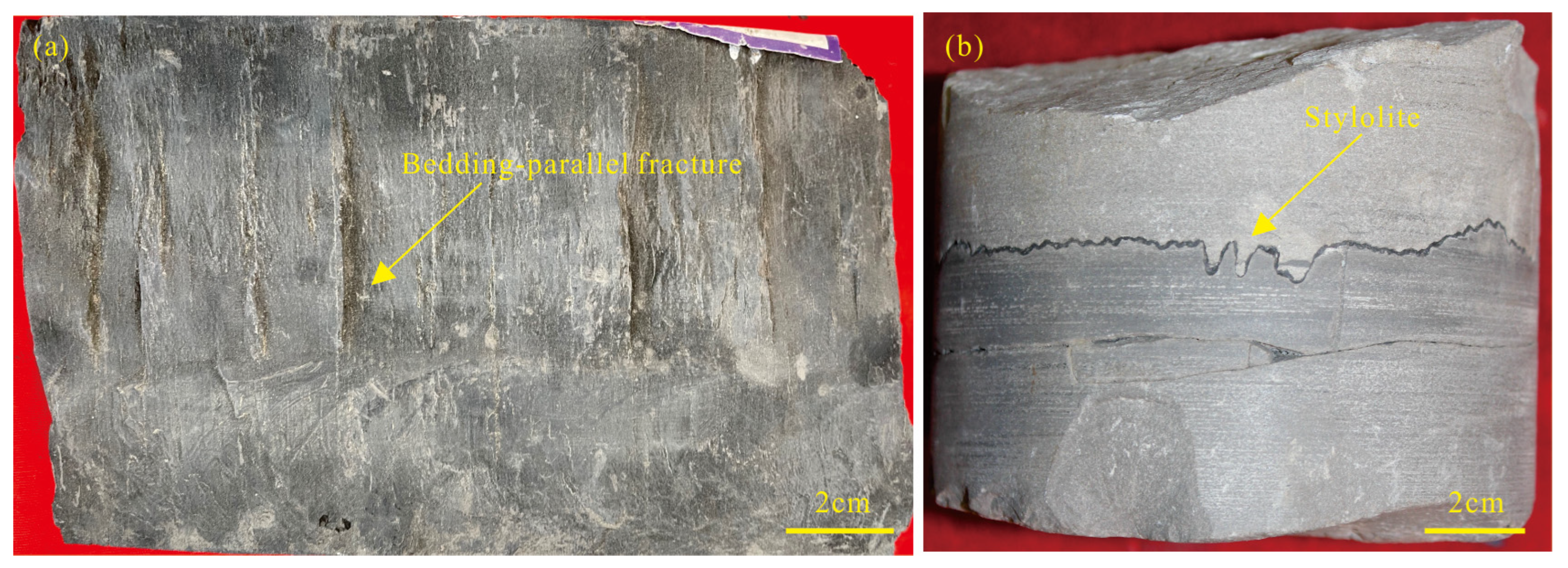
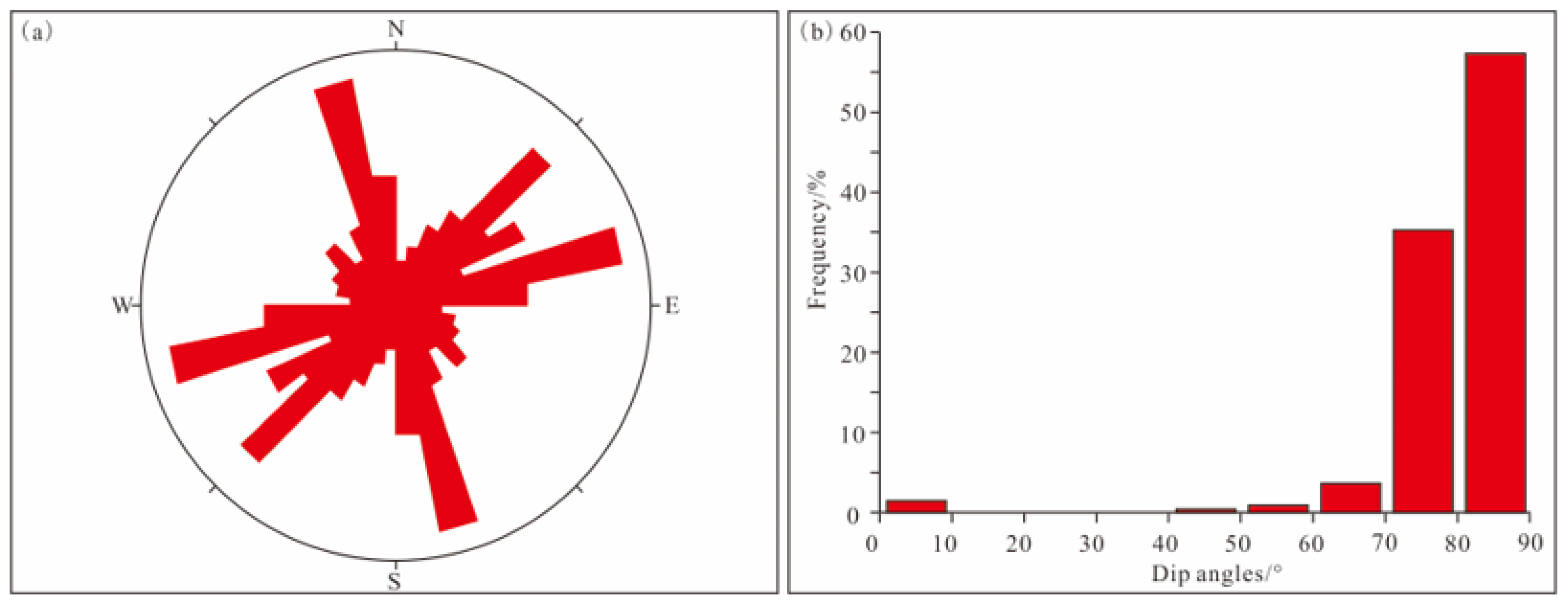
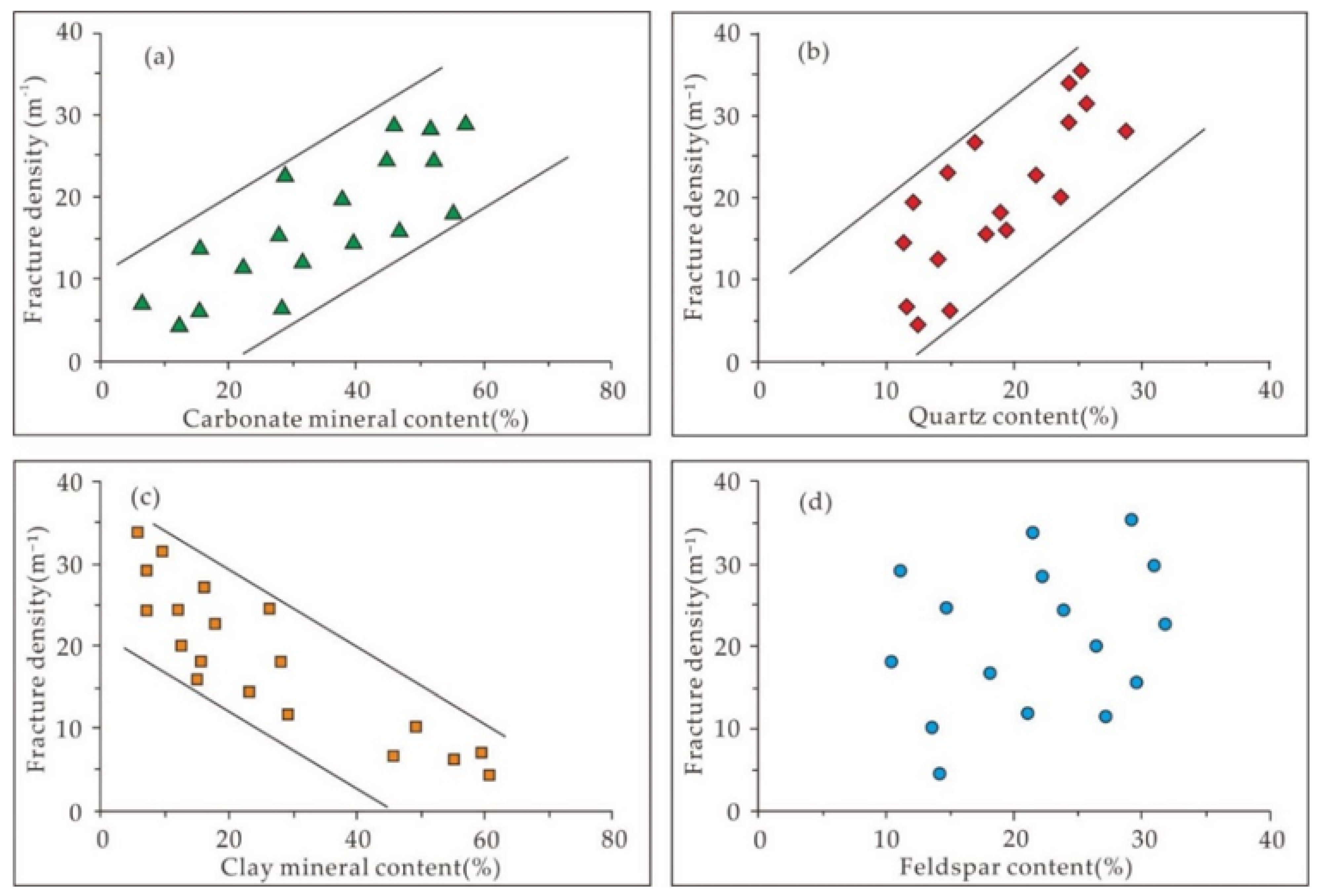
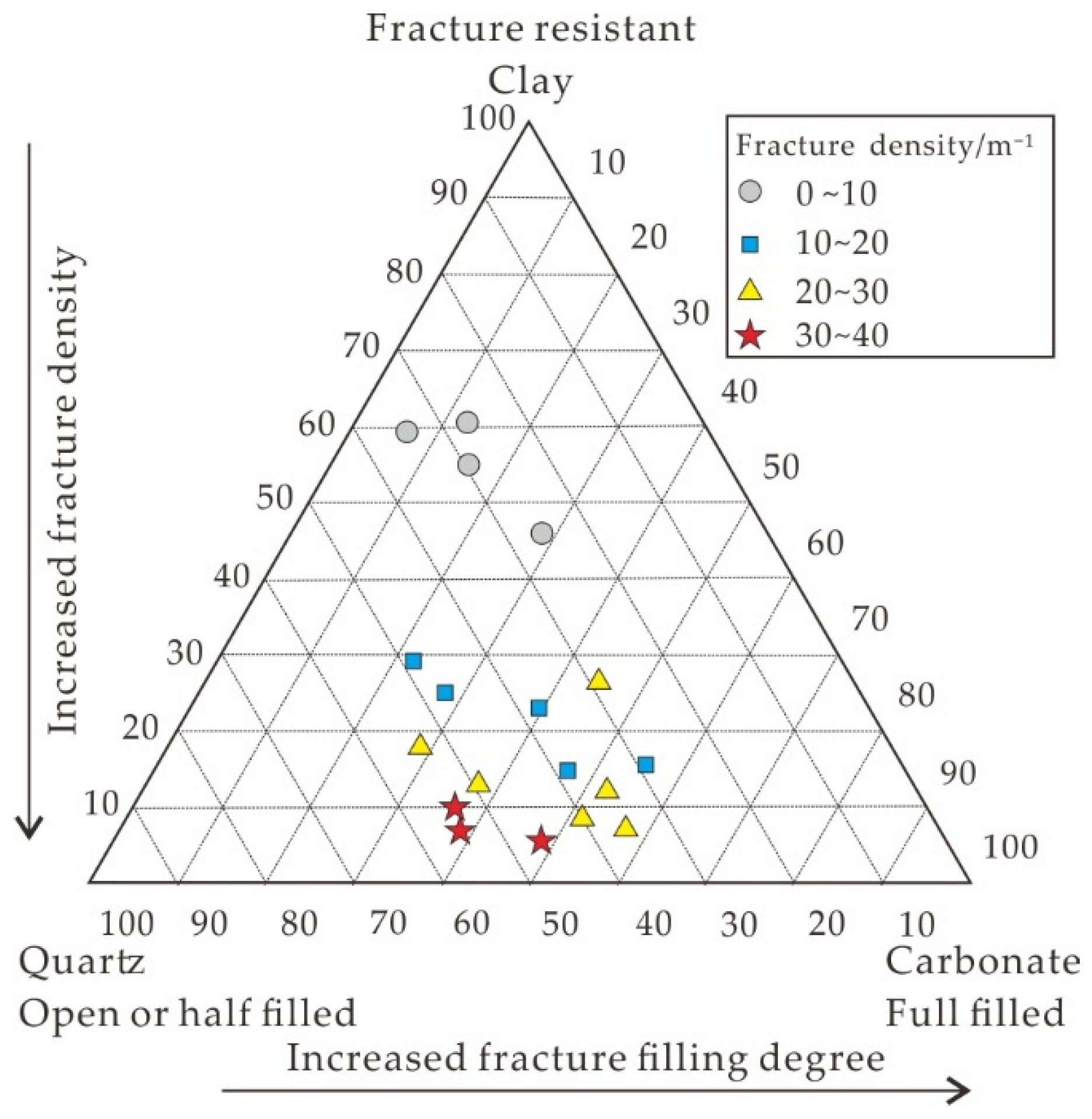
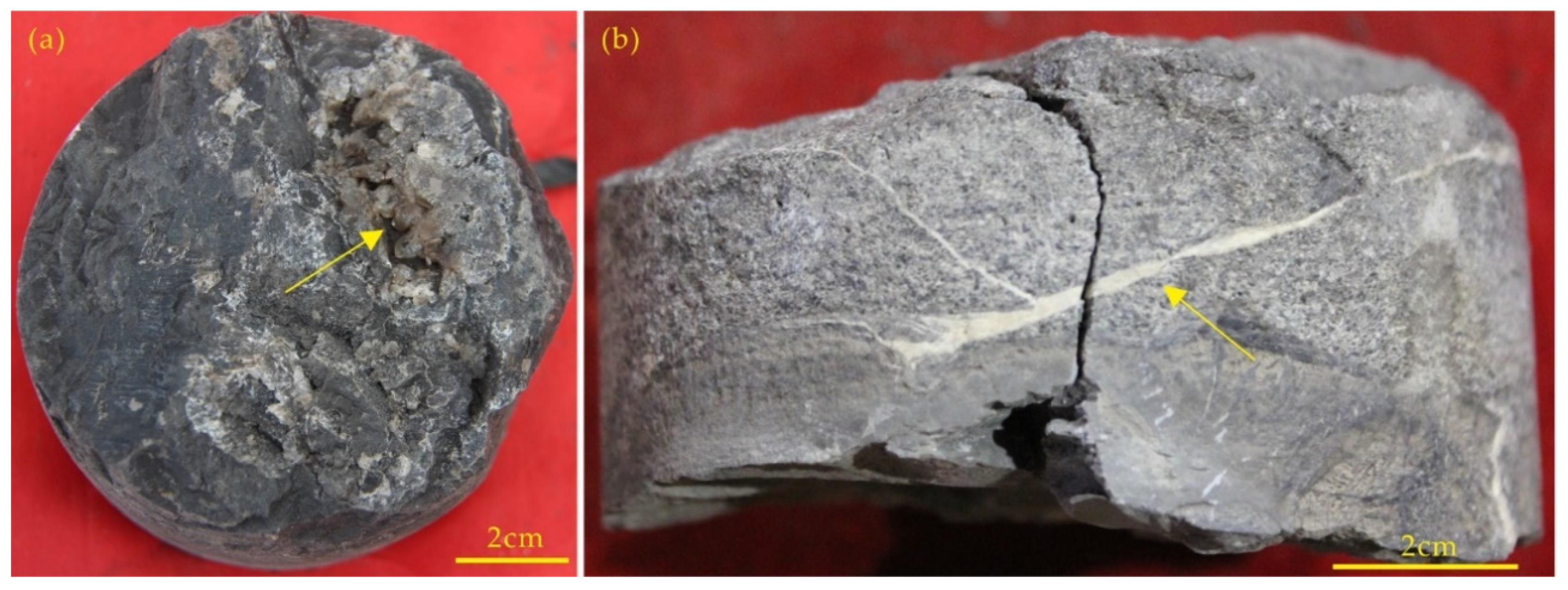
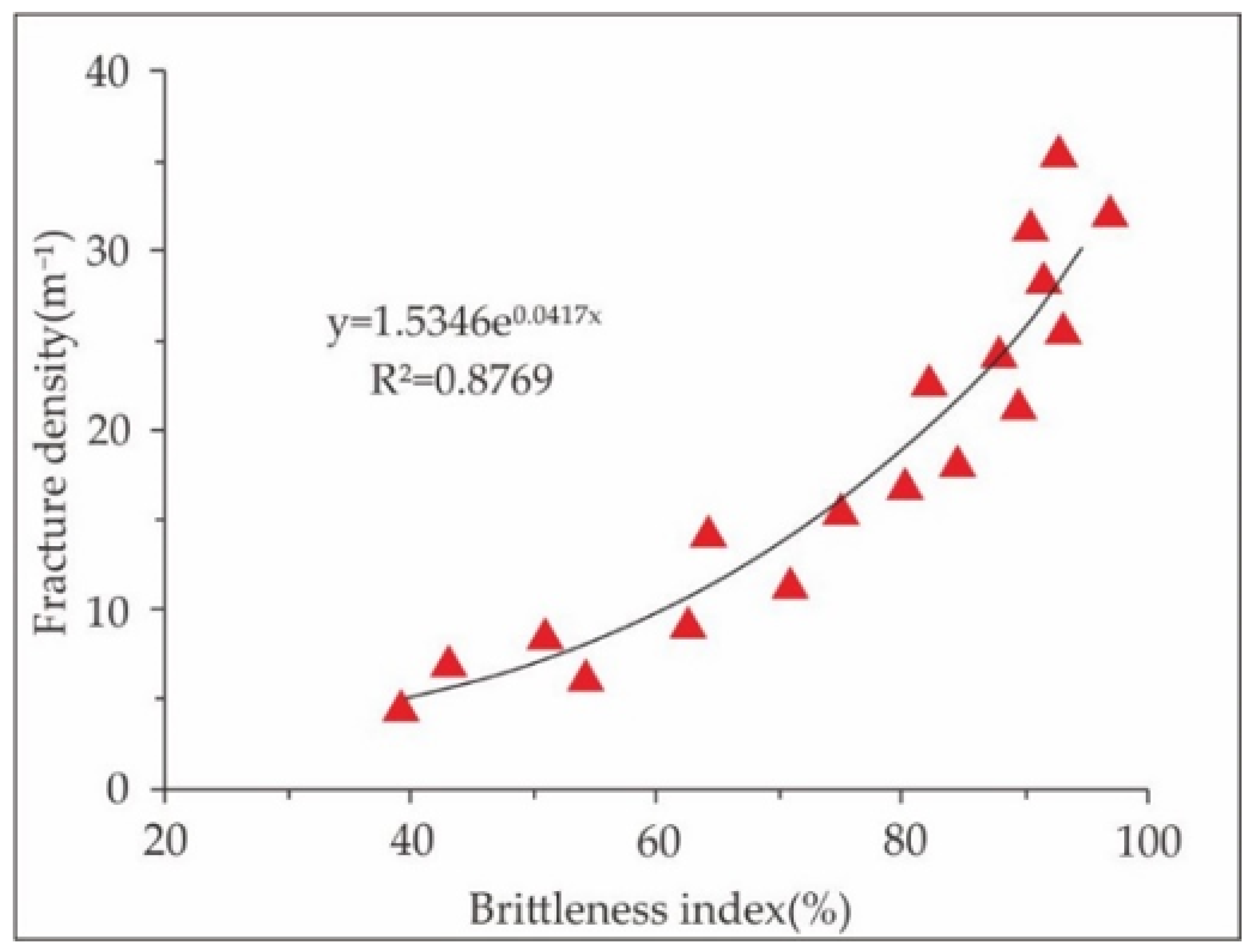
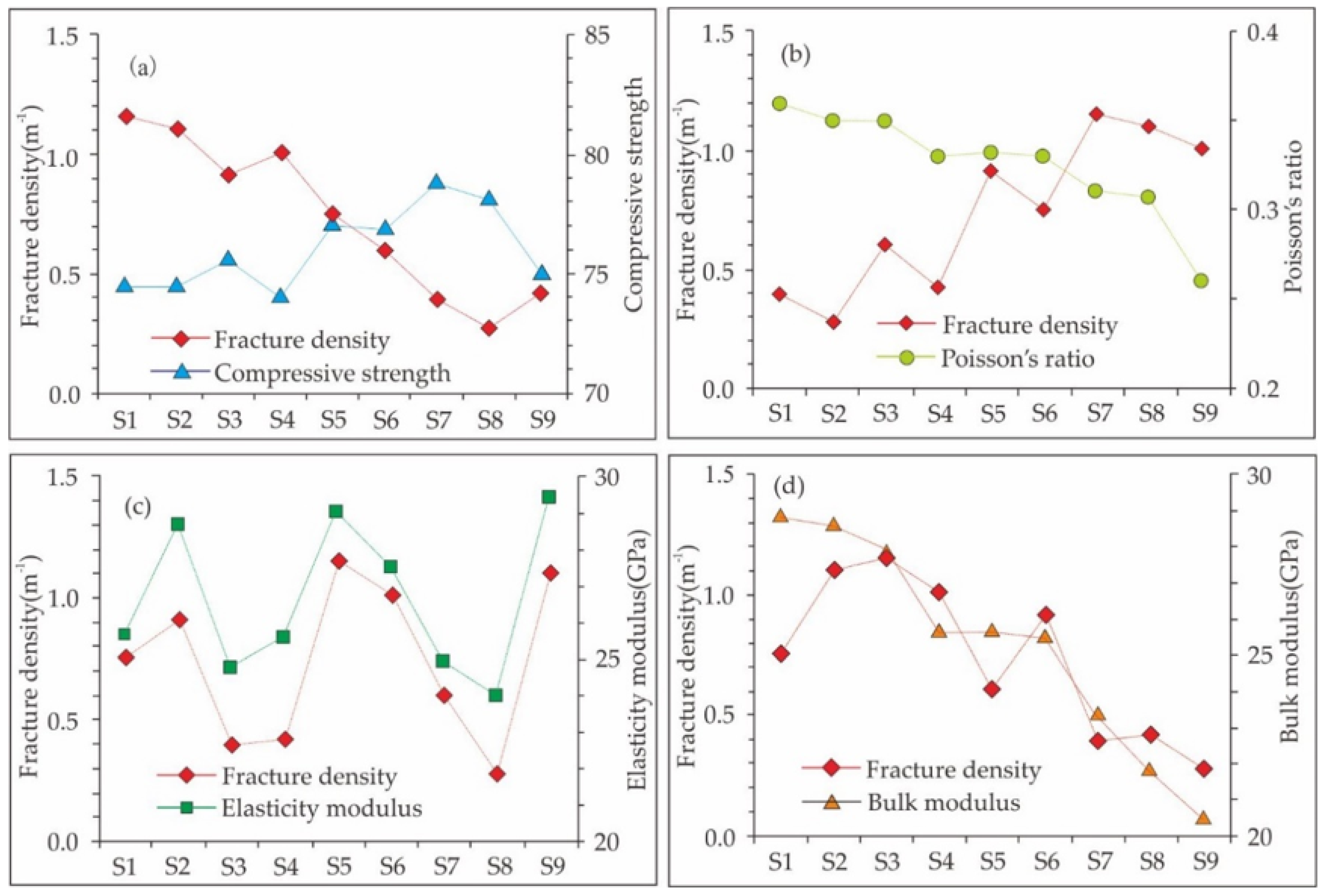

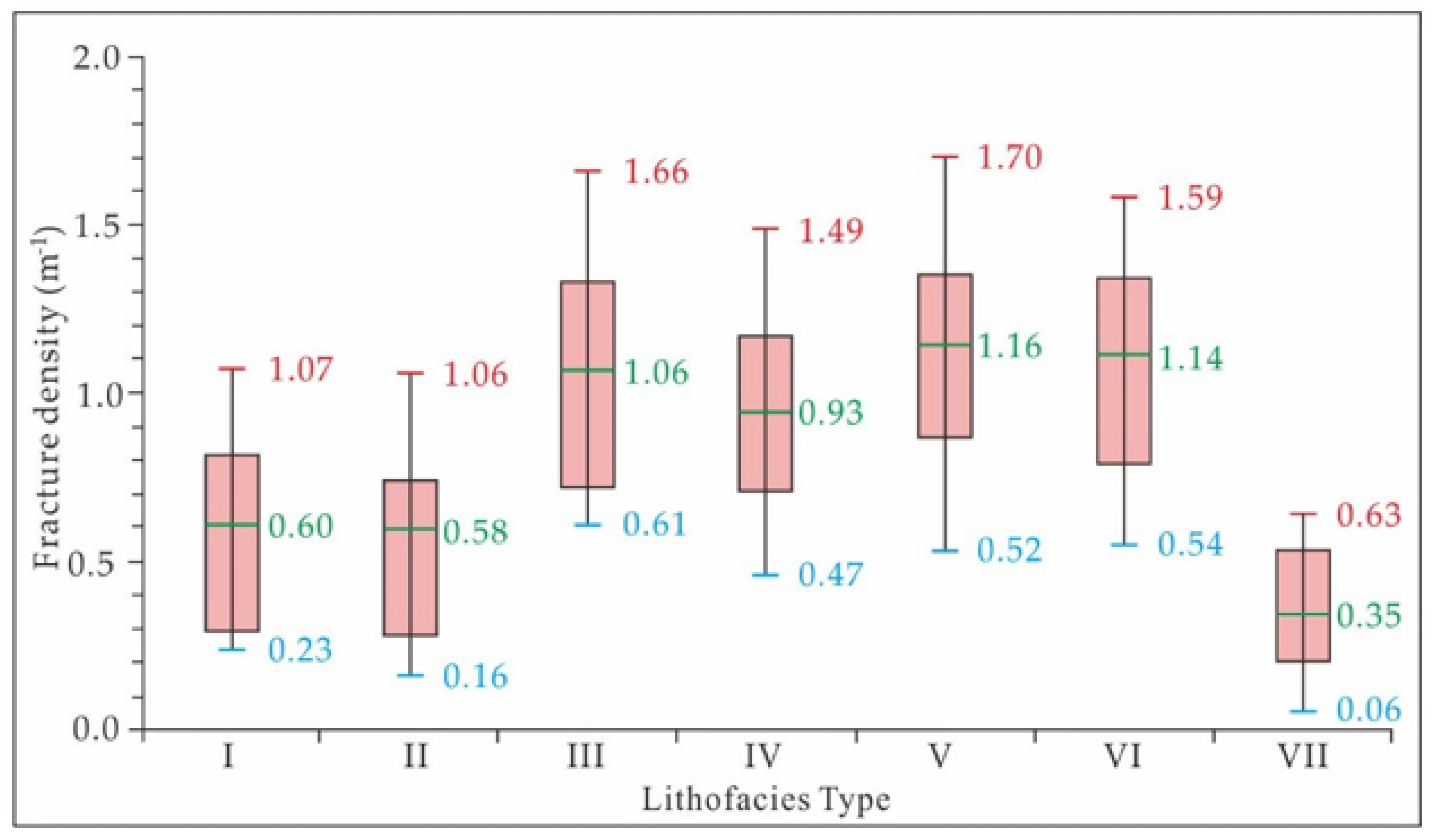
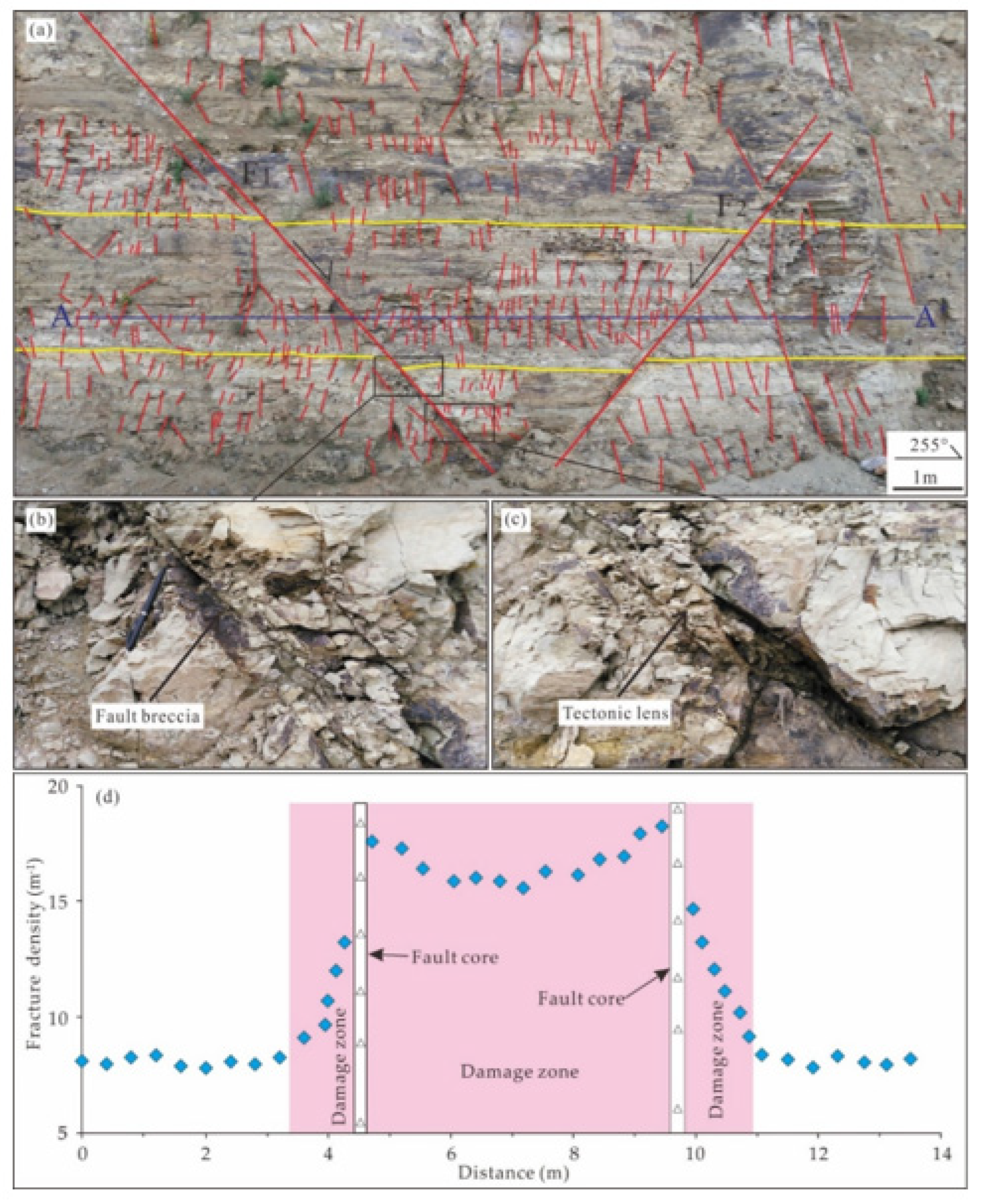
Publisher’s Note: MDPI stays neutral with regard to jurisdictional claims in published maps and institutional affiliations. |
© 2022 by the authors. Licensee MDPI, Basel, Switzerland. This article is an open access article distributed under the terms and conditions of the Creative Commons Attribution (CC BY) license (https://creativecommons.org/licenses/by/4.0/).
Share and Cite
Fu, X.; Gong, L.; Su, X.; Liu, B.; Gao, S.; Yang, J.; Qin, X. Characteristics and Controlling Factors of Natural Fractures in Continental Tight-Oil Shale Reservoir. Minerals 2022, 12, 1616. https://doi.org/10.3390/min12121616
Fu X, Gong L, Su X, Liu B, Gao S, Yang J, Qin X. Characteristics and Controlling Factors of Natural Fractures in Continental Tight-Oil Shale Reservoir. Minerals. 2022; 12(12):1616. https://doi.org/10.3390/min12121616
Chicago/Turabian StyleFu, Xiaofei, Lei Gong, Xiaocen Su, Bo Liu, Shuai Gao, Jianguo Yang, and Xinnan Qin. 2022. "Characteristics and Controlling Factors of Natural Fractures in Continental Tight-Oil Shale Reservoir" Minerals 12, no. 12: 1616. https://doi.org/10.3390/min12121616
APA StyleFu, X., Gong, L., Su, X., Liu, B., Gao, S., Yang, J., & Qin, X. (2022). Characteristics and Controlling Factors of Natural Fractures in Continental Tight-Oil Shale Reservoir. Minerals, 12(12), 1616. https://doi.org/10.3390/min12121616






